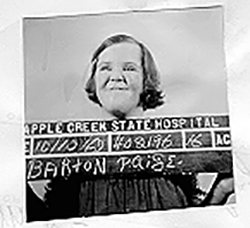Timeline
This exhibit tells the history of the people, ideas, and issues around institutional care for Maine's persons with developmental disabilities, looks briefly at the 25 years of community services that have followed, and brings to light a concerning truth - that as far as we’ve come in our understanding about what people with developmental disabilities need to live full and self-determined lives, there is even now a danger of sliding back into the ideas that led to places like Pineland. We hope that this story brings home the lessons of institutionalization for each person that visits.
Key
Sort By
In the colonial era in New England, people with developmental disabilities were primarily cared for by their families. Without that support, people would often end up as paupers, living on the coffers of the towns they lived in.
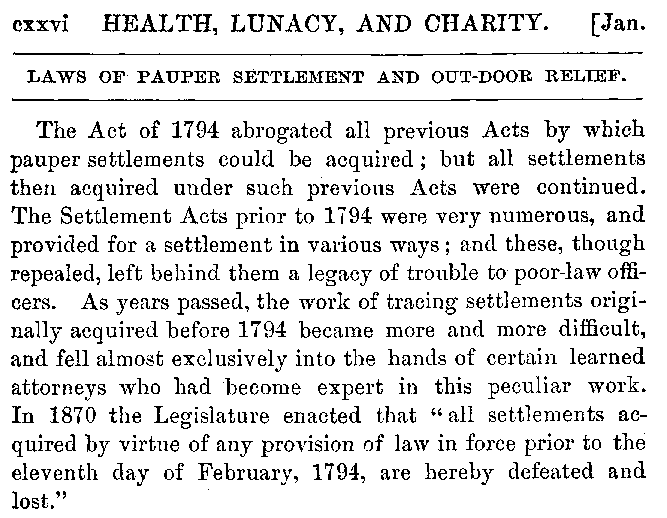
In 1767, the General Court in Massachusetts made changes to settlement laws that decriminalized “transiency” and saw the end of “warning out” as an effective means of avoiding providing aid to those that needed it. Around the same time, custodial care by families began to transition to the more institutional model of Poorhouses and Almshouses.
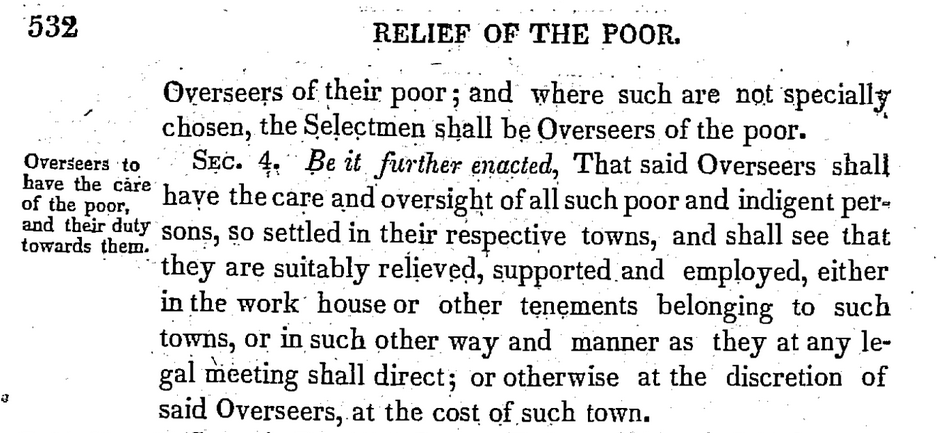
This law led to the rise of “town farms”, also called “Alms houses” or “poor farms” - across Maine, there were perhaps dozens or several hundred. These farms became repositories for all who could not support themselves and had no family to care for them - the poor, the aged, the infirm, and those with disabilities.
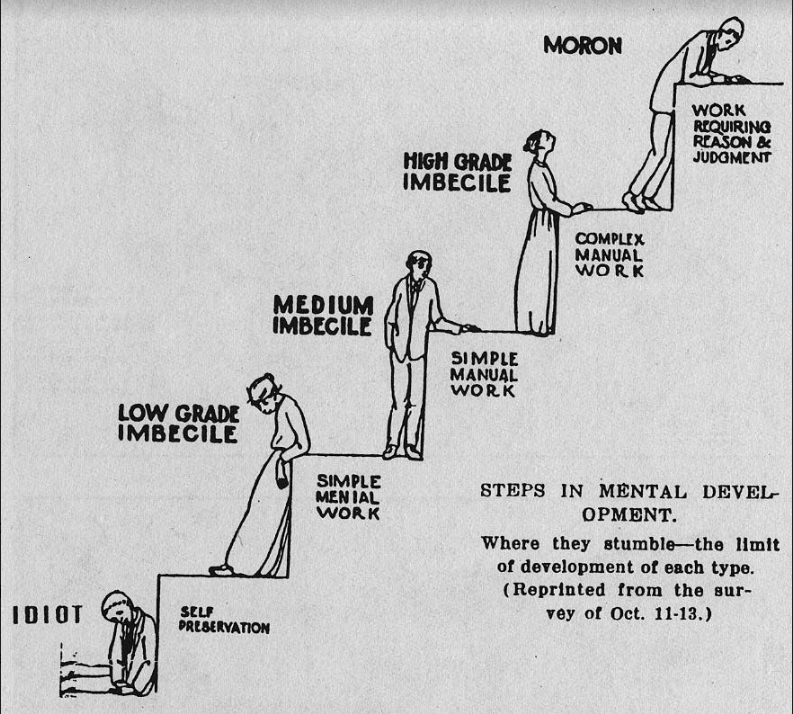
The idea that some of those with developmental disabilities could be trained, and also that they were dangerous or unfit for society if they could not be, led to the rise of the institution.
Born in 1802 in Hampden, Maine, Dorothea Lynde Dix became a fierce advocate for the poor and the mentally ill, who worked to create the first mental asylums in the United States.
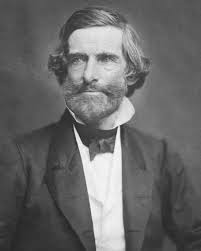
Dr. Samuel Gridley Howe, who began one of the first programs for the "feeble minded" in Massachusetts in 1848, had determined within a decade that he made a mistake and warned against building large institutions.
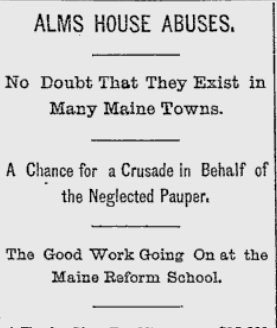
By the late 19th and early 20th century, there were rising calls for a separate institution for those who were called the “feeble minded”.
In the revised statutes of 1903, compulsory education for children ages 7 to 15 was the law - but with an exclusion carved out for “any child whose physical or mental condition makes it inexpedient for him to attend.”
The recommendation of the Committee was unequivocal: “After full investigation of this subject, we most earnestly recommend to the legislature of Maine, that humanity demands at our hands the location of such a home for this unfortunate class: that economy and the protection of society demand it.”
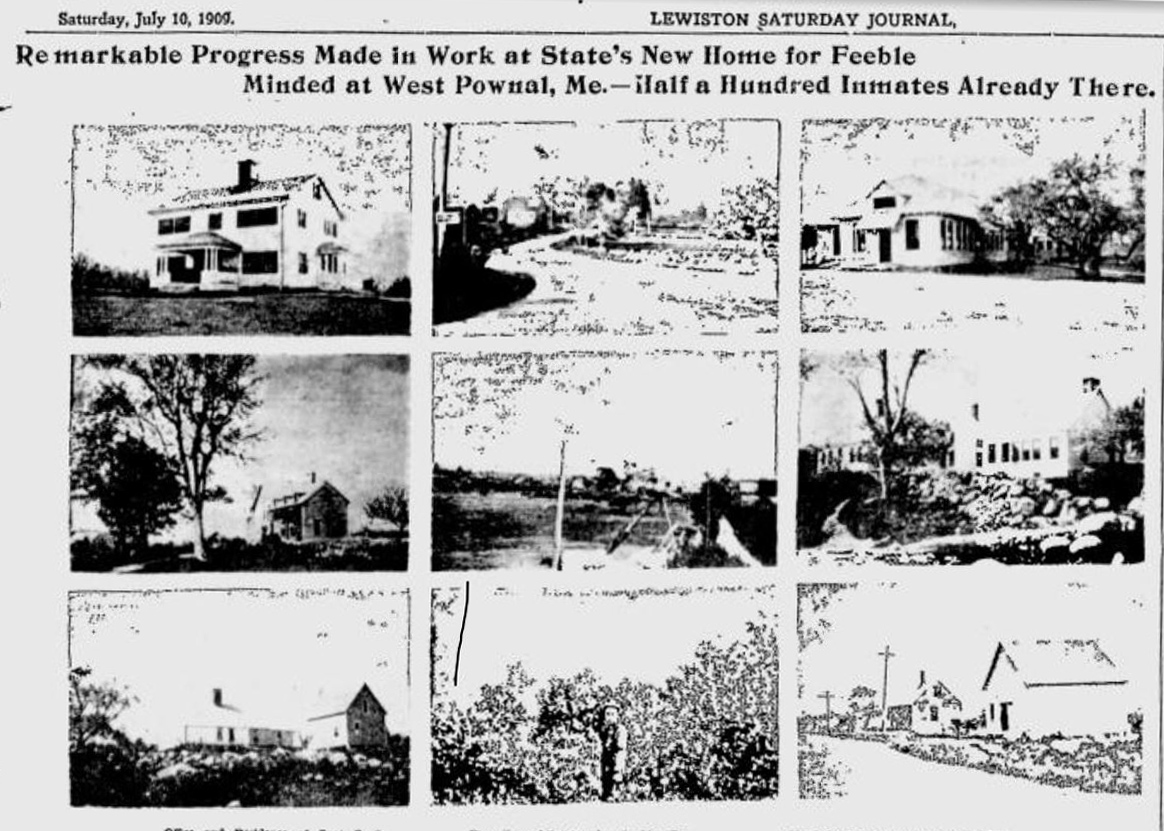
"Remarkable Progress Made In Work At State's New Home for Feeble Minded at West Pownal," a newspaper headline announced on July 10, 1909.
Laws passed over this decade allowed judges to commit people to the School, placed power in a Board of Trustees, and criminalized any who tried to run away or those that helped "fugitives". The population of residents swelled during this time, fueled by calls to expand: "the state must plan to care for, altogether, at least 1500 persons of this class."
Only three years after the Maine School for the Feeble-Minded opened, a visiting committee identified problems.
![Lewiston Evening Journal, July 15, 1911 Newspaper Clipping from Lewiston Evening Journal, July 15, 1911 – Headline: Burn ‘Em Up Says Gov. Plaisted: Who Would Remove Malaga Island Natives to Institution. Body: The official visit to Malaga Island made by Gov. Plaisted, Council and guests on Friday, may lead to some radical measure being taken with the residents of that more or less unsavory place. The visit was promoted by Hon. E.B. Winslow of Portland, and the party wore his guests for the day. He had chartered the steamer Machigonne and had provided in every way for the comfort of the party which was made up as follows: Governor Frederick W. Plaisted, Mrs. Plaisted, Miss Gertrude Plaisted, Mrs. Elma Woodbury of New York, Hon. And Mrs. Charles L. Turgeon of Auburn, Hon. And Mrs. Weston Lewis of Gardiner, Hon. and Mrs. C.G. [cut off]](https://shadowsofpineland.org/wp-content/uploads/2021/07/1911-July-15-Lewiston-Evening-Journal.png)
Maine’s Malaga Island in the late-19th and early-20th centuries was inhabited by a mixed-race community of fishermen and families. In the early 1900's, fear and racism turned public opinion against the people of Malaga, and many inhabitants of that island were sent to the School for the Feeble Minded.
Just six years after the institution opened, a headline announced "Care of Feeble-Minded Big Problem for Maine." The facility already had 255 people receiving care, with 160 on a waiting list.
Alongside blaming heredity for causing intellectual disabilities, those with such disabilities were demonized and blamed for all the ills in our society - women of “feeble mind” were said to be promiscuous - and of course would “breed” more generations of “defectives” with their loose morals.
The name of the institution was changed from the "School for the Feeble Minded" to "Pownal State School" and the 82nd Maine Legislature Maine passed a sterilization law to "prevent reproduction of feeble-mindedness or in treatment of mental disease."
A new bill on sterilization was signed into law. This law made it easier to recommend these procedures for residents of institutions like Pineland, and coerce people with developmental disabilities, most of them women, to be sterilized.
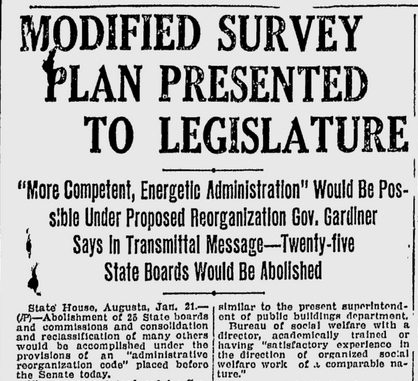
Alongside the growth of centralized institutional care for people with disabilities, the early 30s brought a parallel consolidation of governmental administration under the executive branch, including the creation of the Department of Health and Welfare.
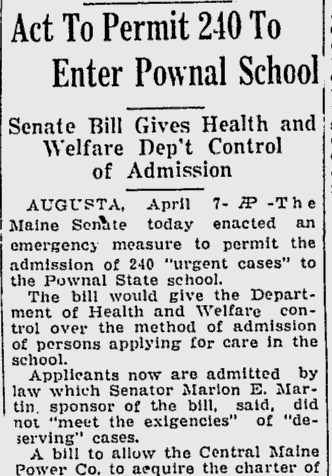
While changes were being made to the administrative structures of Maine’s institutions, the Pownal State School was undergoing an expansion as well. An increase in beds and buildings was championed by a new superintendent, Dr. Stephen E. Vosburgh, who was hired in 1919 and served for 18 years.

In 1938 came the first whispers of something more sinister, when a former Superior Court judge accused the institution of neglect.
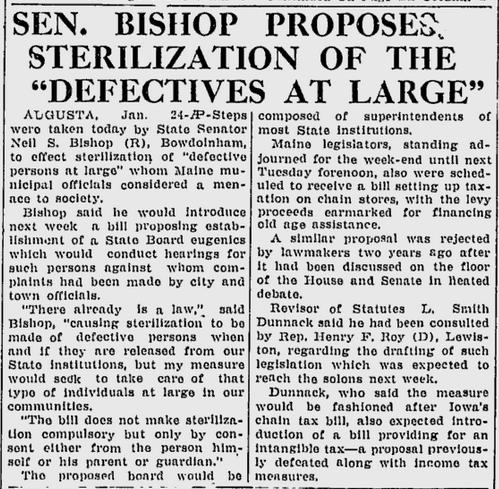
In 1941, a bill came before the legislature to create a “State Board of Eugenics”, which would allow for involuntary sterilizations of “defectives” not residing in institutions.
Residents of Pownal State School were allowed to be granted the right for a temporary “leave”.
While the patient population would peak in the 1930s at around 1,500, Superintendent Kupelian would continue to advocate for expanding the numbers of residents - asking the public to support funding for up to 9,000 total patients.
Governor Hildreth signed into law a bill creating the Division of Special Education for Physically Handicapped Children under the Maine Education Department. While it only provided for children with physical disabilities and the “special” classes were separate from their “normal” peers, this bill was a step towards providing an education for every children regardless of disability.
The Maine Federation of Women's Clubs expressed concerns about conditions at state institutions and found overcrowding, staff shortages, and inadequate food and clothing.
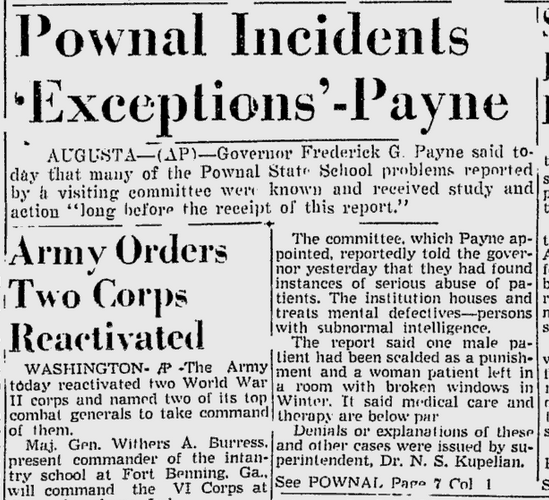
A Visiting Committee in 1951 cited cruel and abusive treatment, including excessive use of straightjackets, euphemistically known as "camisoles," and physical punishments. Superintendent Peter Bowman reported that some patients had been "scalded, beaten, and sexually abused in the recent past." But, Bowman stressed, most employees were caring and tried to do the best for residents – but were hampered by inadequate facilities, and staff shortages.
In 1954, a group of parents formed a support and advocacy group: Pownal Parents and Friends. When the news of abuses came to light these parents were horrified, and began to organize towards investigating further and improving conditions for their children and family members living in Pownal. These groups and others like it would form the basis of the community care system in Maine.
While still segregated from their non-disabled peers, this law opened up opportunities to children with developmental disabilities.
The Maine Legislature, as such bodies are wont to do when faced with intractable systemic problems, on the recommendation of the Legislative Research Committee in 1955 created a Governor’s advisory committee to study the issue - the Maine Committee on Problems of the Mentally Retarded.
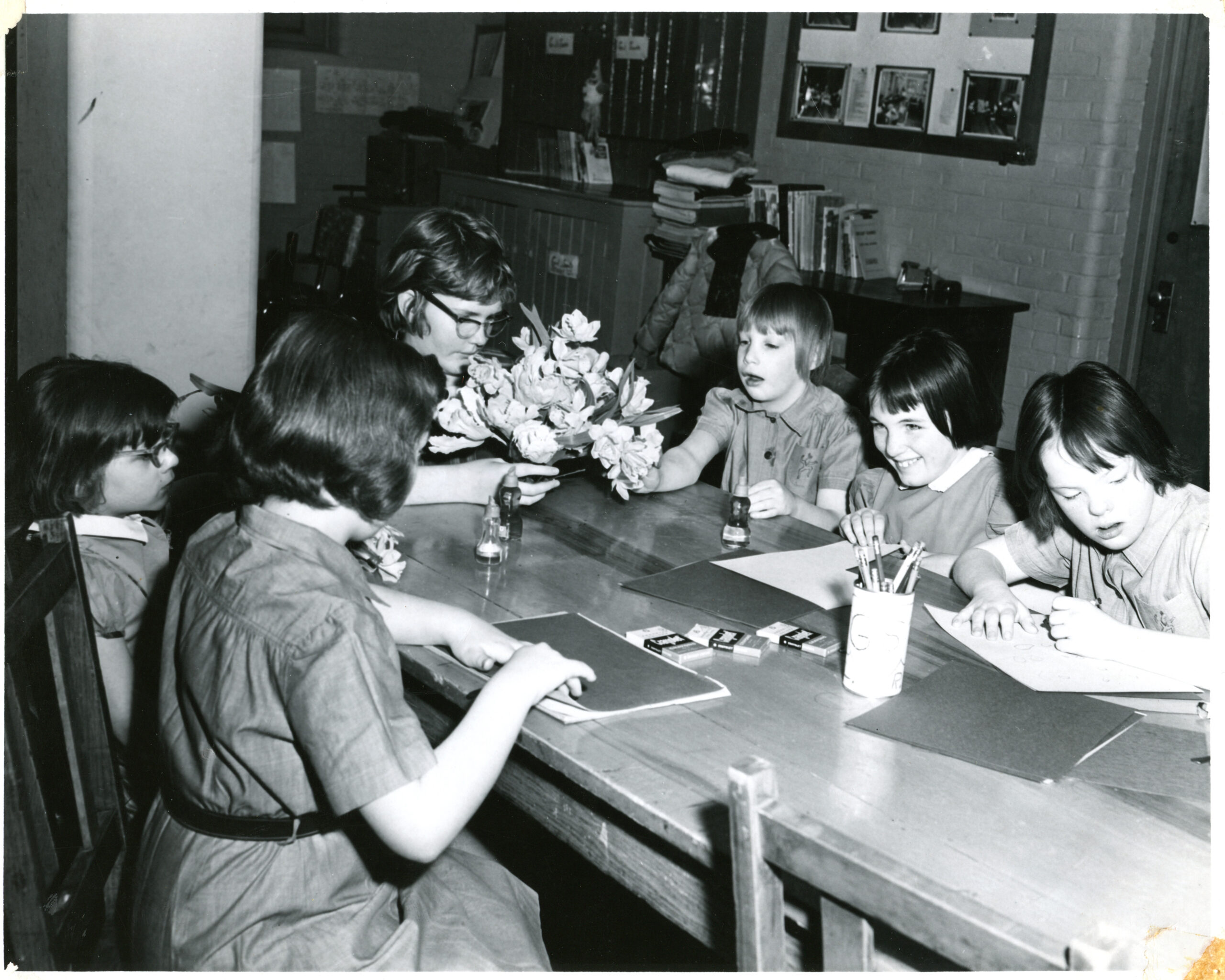
Superintendent Bowman himself began to express the view that many of those at Pineland could and should be returned to the community: “the mission and objective of Pineland is to return to the family, the community, and to outside civilization as many of the patients as possible, after they have received the maximum training and education we can provide here.”
This bill allowed municipalities to raise funds for “the education of teachers to meet the education needs of mentally retarded children”, and pledging matching funds from the State.
“The Bureau of Mental Health shall be responsible for the direction of the mental health programs in the institutions within the department and shall be responsible for the promotion and guidance of mental health programs within the several communities of the State.”

New ideas were cropping up - it was beginning to be understood that services provided in the community were both more humane and less expensive. But even as a new infirmary to “house 134 totally dependent patients” was dedicated, Governor Reed called for more, saying, “the needs of this and other state hospitals continue to grow".
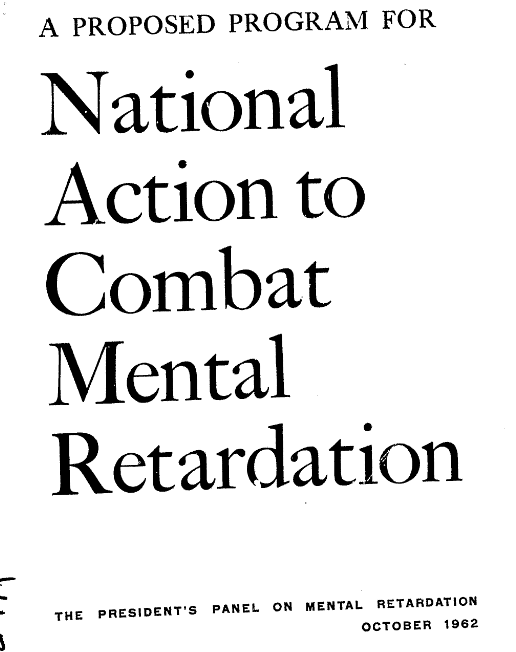
President John F. Kennedy had a personal connection to institutionalization and as President he would bring developmental disabilities into the public eye, and make the reenvisioning of services for people with developmental disabilities a cornerstone of his policies.
Congress passes the Maternal and Child Health and Mental Retardation Planning Amendments, which would create funding for both services for children with disabilities and grants to “plan for and take other steps leading to comprehensive State and community action to combat mental retardation”.
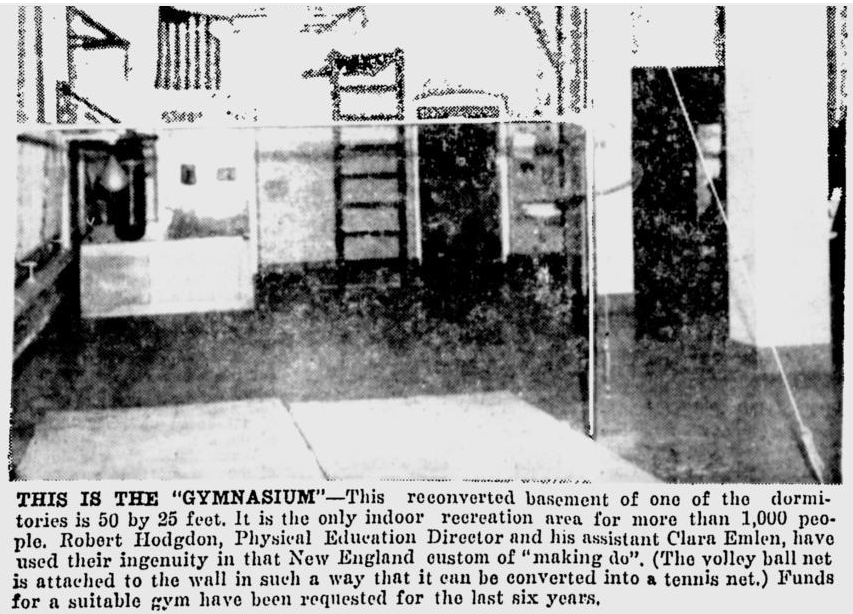
Staffing issues and high turnover was a constant refrain in the mid-1960’s in Maine’s institutional system. In 1965 it was determined that Maine’s turnover rate in this industry was twice the national average.
Another “responsibility” that was granted to this new department was control over people with developmental disabilities who were determined to need guardianship, and who didn’t have family members willing or able to be guardians.
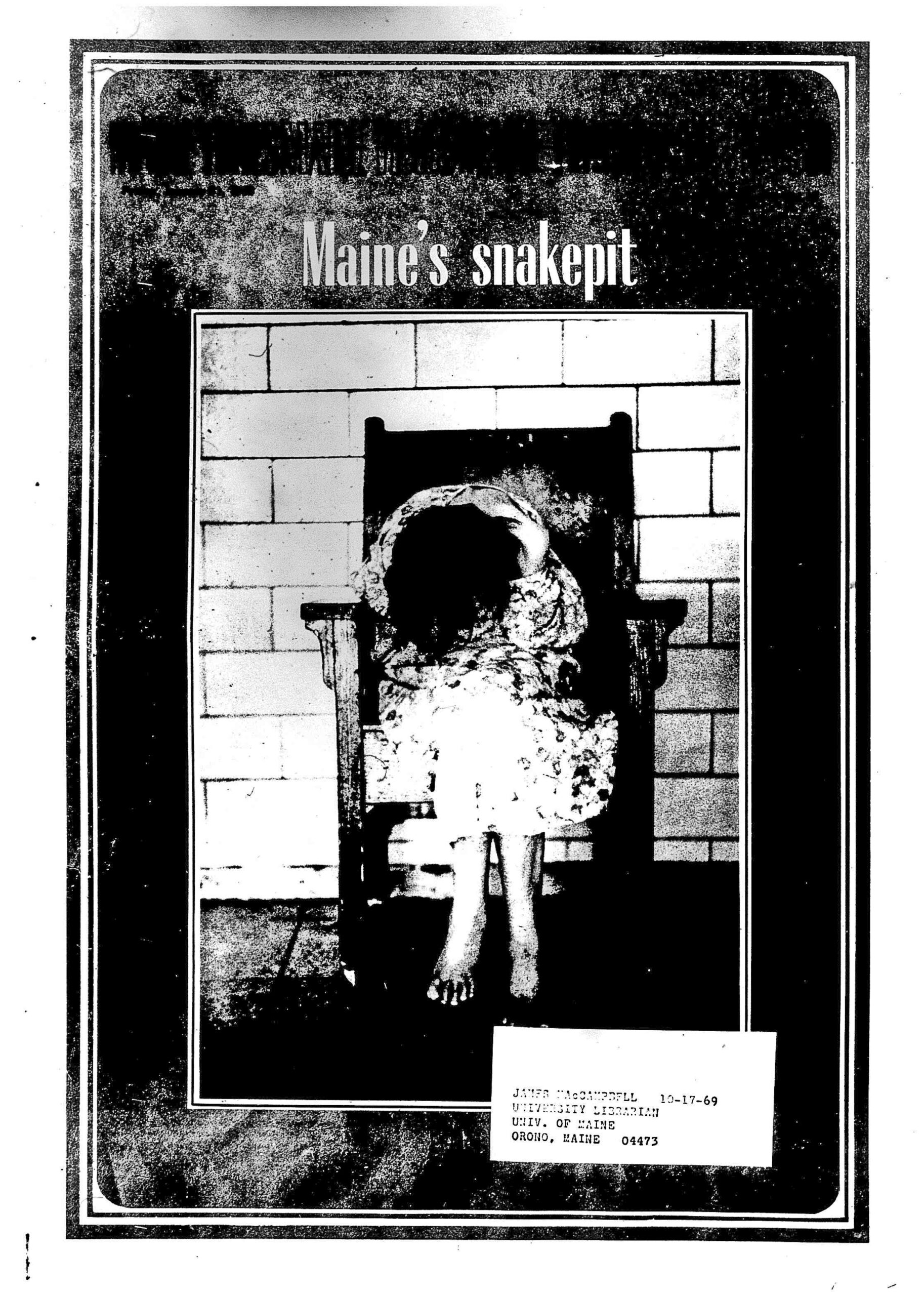
A Maine Times exposé in 1969 revealed overcrowding, residents with inadequate clothing, staff shortages, and deteriorating facilities. Another exposé, in The Church World in 1972 found similar problems.
On the ballot in 1969 was a referendum bond issue for $2.5 million in funds to “enlarge and improve” institutions, which passed by a large margin. Complaints brought by staff around pay and hours were also addressed.
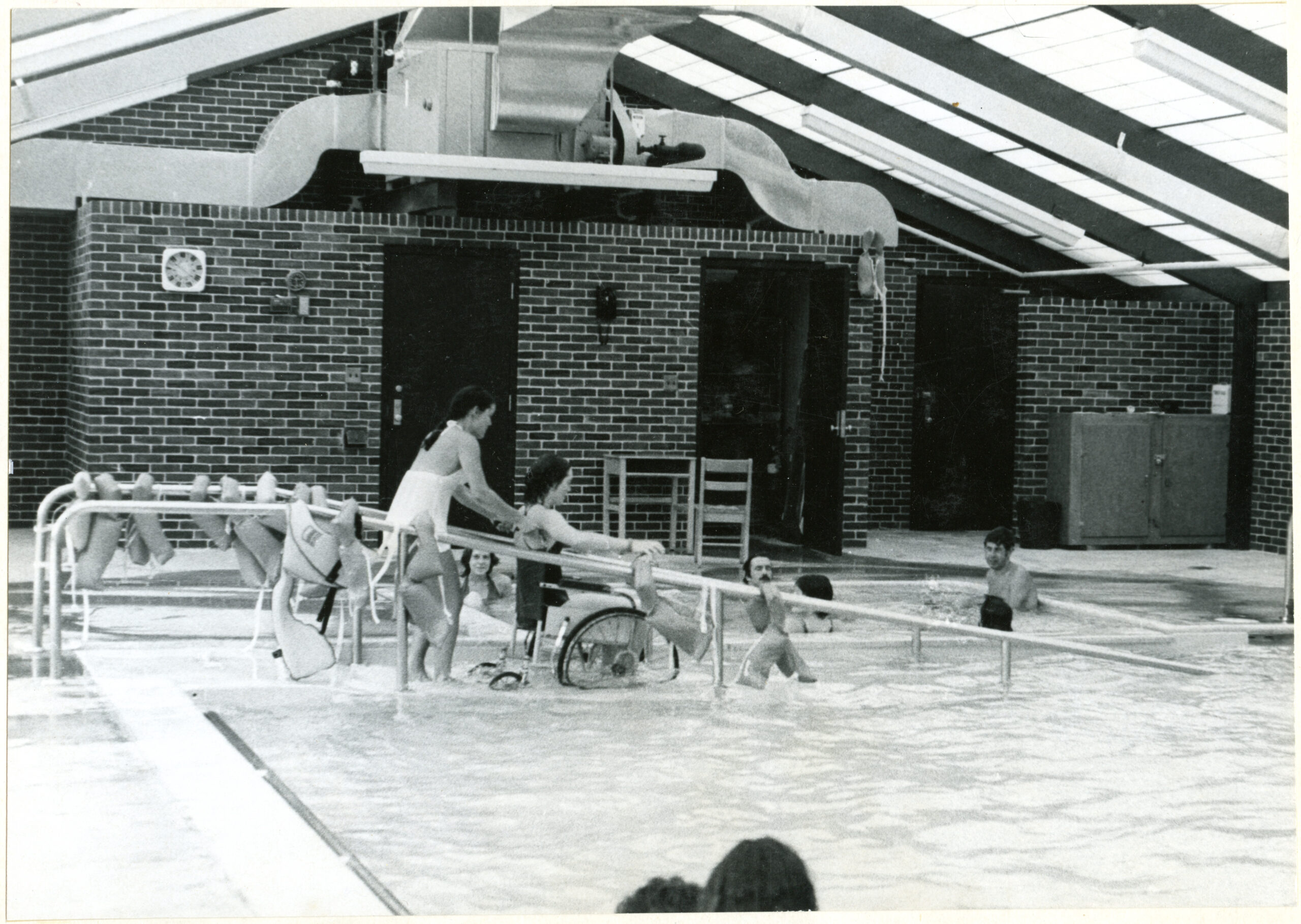
Change and reform were in the air at Pineland, but despite some new ideas and improvements, problems continued.
This Federal amendment to the 1963 Community Health Centers Act gave states the responsibility for making and implementing plans for comprehensive community services for people with disabilities.
This act was the first federal law that protected the civil rights of people with disabilities, providing that people with disabilities could not be excluded from or denied participation in any program that received federal funding - including schools, healthcare, and government assistance.
This law finally included children with disabilities in public education in an inclusive way, mandating that all children have the right to a “free and appropriate public education” in the “least restrictive environment” possible.
This law provided clearer definitions of developmental disabilities that included specific conditions and specified that the conditions originate before the age of 18 (raised to 22 in 1978), are expected to continue indefinitely, and represent a serious handicap.
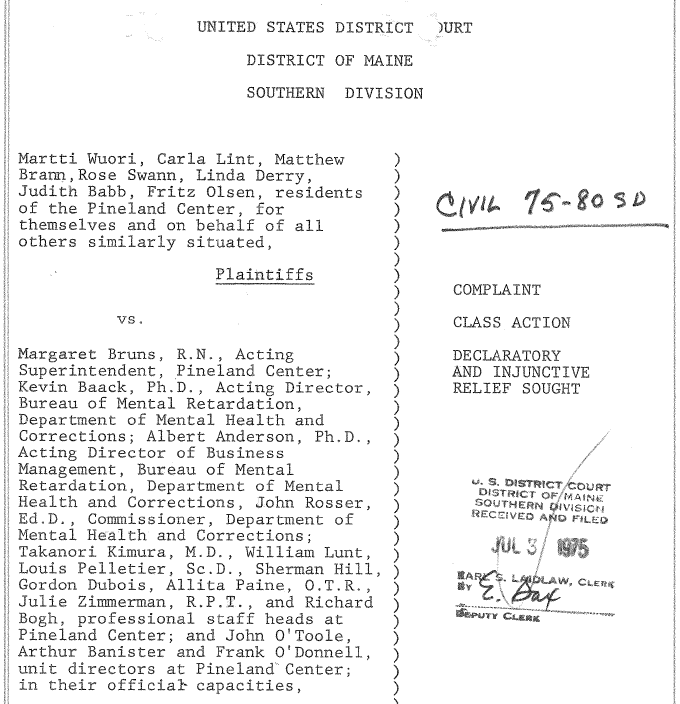
Pine Tree Legal Assistance, the first organization in Maine to provide free legal assistance to those in poverty, filed in federal district court in Maine on July 3, 1975 the lawsuit Wuori v. Bruns, alleging that the six defendants named in the case, and the "class" – all other residents and future residents – were not getting "training and education which would enable them so far as possible to lead normal lives."
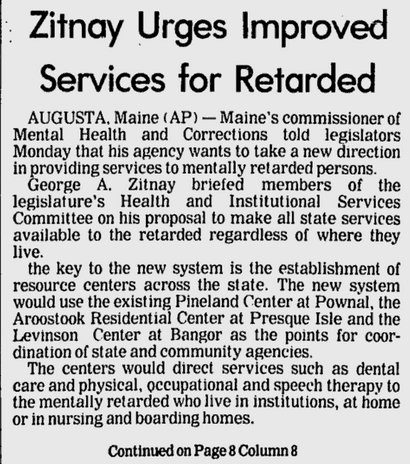
The years while the lawsuit worked its way through the courts were marked by much upheaval and many changes at Pineland. Many policies were beginning to be implemented in order to give Pineland residents more autonomy, choice, and opportunities.
The state decided to settle the lawsuit, rather than go to trial. The result was a two-part consent decree that detailed rights of persons with developmental disabilities at Pineland and in the community.
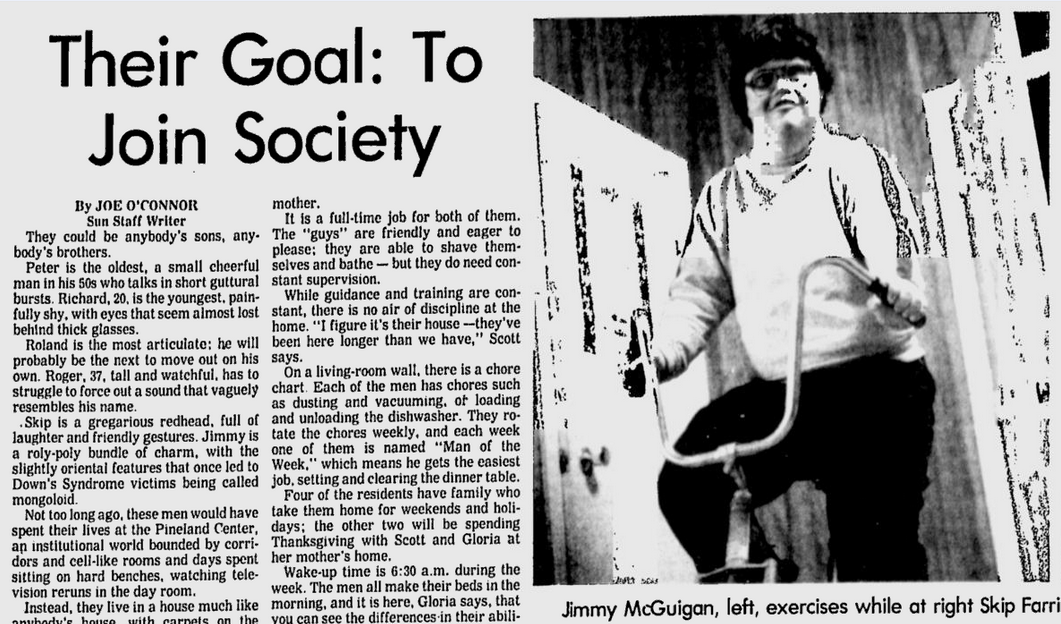
Neville Woodruff, the lawyer who represented Pineland residents in the lawsuit, threatened new suits against Pineland saying, “They are very far behind in three major areas - staffing, quality of programs, and staff training.” Court Master Gregory was critical of the lack of improvements at Pineland as well, saying residents were “still just being kept. Life for them is purposeless."
Governor Brennan appointed a “Task Force on Long Term Care for Adults” to study the systems of long term care as they stood and bring back policy recommendations to the administration.
The new law gave a bit more freedom for marriage, but still denied anyone “impaired by reason of mental illness or mental retardation to the extent that he lacks sufficient understanding or capacity to make...responsible decisions” the right to marriage.
The Legislature passed a law into statute requiring the Department of Human Services to provide in-home and community support services for adults with long-term care needs.
This law broke the Department of Mental Health and Corrections into two separate agencies.
With public and policy sentiment turning towards the idea that people with developmental disabilities deserved the right to care in their communities and a full life with control over their choices, a new system needed to be built from the ground up.
Furthering the gains of the 1973 Rehabilitation Act, the ADA protects people with disabilities from discrimination not just from the government, but from employers and businesses that provide public accommodations.

Despite all the systems in place to ensure compliance, problems arose. New criticisms of inadequate funding, staff shortages, not enough community options, lack of proper oversight of persons moved into the community, and other non-compliance led to another lawsuit. In the meantime, the state had decided to close Pineland.
The IDEA law of 1990 built upon the the Education for All Handicapped Children Act of 1975 - further enshrining the main elements of an inclusive education.
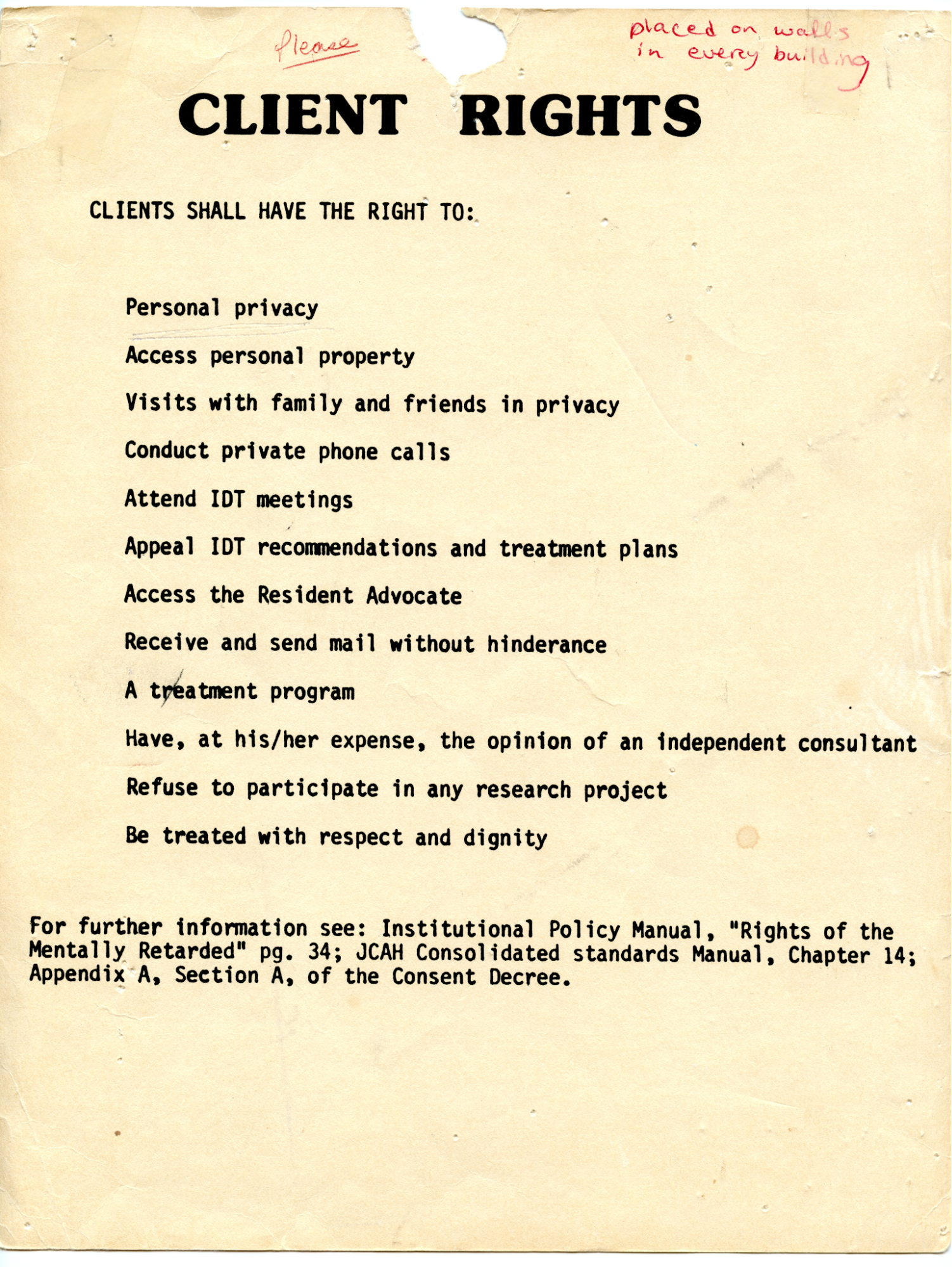
The transition from institutional to community living and care was not easy for many Pineland residents, nor was it easy for those setting up and trying to operate housing and various services.
While Maine was working to build a system of care for people with developmental disabilities outside of institutions, a legal case before the Supreme Court finally codified the idea that people with developmental disabilities had the right to life in the community.
Despite a growing understanding that community-based services were a better choice for individuals than institutionalization, switching from a consolidated and hierarchical system to one of many service providers helping smaller numbers of clients follow personalized plans for success was difficult, and the path forward had many hurdles to overcome.
In February of 2000, in response to the federal Olmstead decision requiring services for people with developmental disabilities in the least restrictive environment possible, the Commissioner of the Department of Human Services created the Workgroup for Community-Based Living.
In an attempt to consolidate and eliminate bureaucracy, in 2003 a bill was proposed at the Legislature to merge the Department of Human Services and the Department of Behavioral and Developmental Servicers (formerly the Department of Mental Retardation) into one department: the Department of Health and Human Services.
The second decade of the 21st century ushered in big changes to state government. An economic downturn and a new administration ushered in alongside others in an austerity-based, small government movement led to budget cuts and staffing freezes at the Department of Human Services. Over this decade, waitlists for services exploded, especially for Section 21 services, which serve those who need daily support to live full lives.
The impulse toward institutions continues as some community-based facilities for developmentally disabled persons grow in size and the people they serve become less integrated in everyday community life and less in control of their own lives.








